Are you a Quiet Speculation member?
If not, now is a perfect time to join up! Our powerful tools, breaking-news analysis, and exclusive Discord channel will make sure you stay up to date and ahead of the curve.
Randall Thompson has been working on and playing Lantern Control since March of 2013, working alongside many other architects of the deck, including GP Oklahoma City winner Zac Elsik, in the MTGSalvation forums.
Lantern Control has recently attained notoriety in the Modern community. The existence and nature of the deck is often one that sparks debate and heated opinions, but there is no doubt of the power of the deck in the hands of a capable pilot. It is mainly known by this year’s two Top 16 finishes, along with sporadic presence among smaller tournaments. Zac Elsik put this deck on the map with his 15th place finish at GP Charlotte, and with his recent win at GP Oklahoma City, the deck is sure to be shredding Modern tournaments for months to come.
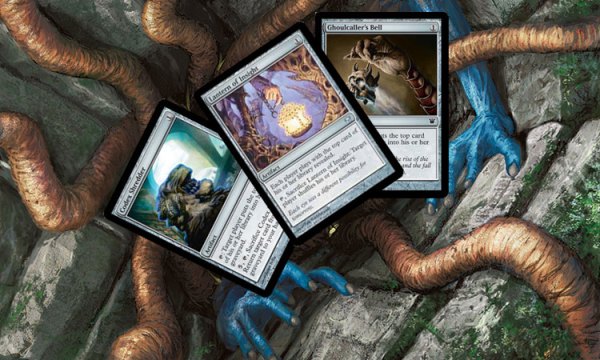
While there are still those who may doubt the effectiveness of combining the information that Lantern of Insight provides and the draw control that Codex Shredder and Ghoulcaller's Bell provides, it seems only a matter of time before the deck becomes a major player in the Modern metagame. This goal of this primer is to examine and explain the deck and its nuances. Before we get started, I want to give a huge shoutout to the players, brewers, and testers in the MTG Salvation Lantern Control thread for all their work and deck development.
[wp_ad_camp_1]
Examining the List
Let’s start with a look at two versions of the deck: my own list, and then Zac Elsik's GP-winning list from last weekend's GP Oklahoma City.
Lantern Control, by Randall Thompson
Lantern Control, by Zac Elsik (GP Oklahoma City 2015, 1st)
Most players' first introduction to Lantern Control came from Zac Elsik’s GP Charlotte list and Ali Aintrazi’s SCG Open Charlotte list. After this weekend, Zac Elsik's GP Oklahoma City list is sure to hype the deck even more. The core strategies and synergies that make Lantern Control work mean that few differences are apparent between decks.
Lantern Control is probably one of the, if not the, most complicated decks to pilot in Modern. Every decision, from what order to play cards, to what cards to allow the opponent to draw once the combo is constructed, has an enormous influence on whether the pilot is going to win or lose. In addition, simple choices in what cards to supplement the prison pieces in a given metagame may impact the success of the deck.
Card Choices: The Maindeck
Supplemental choices are varied, and a tremendous number of options have been cyclically tried, discarded, and tried again by each pilot who decides to adopt the deck. The history of the deck goes back some years now, and through the combined work of dedicated players, the list of cards that have been found to be most effective has narrowed. For more information on what cards were tested and what cards are good or bad for certain metagames, you can check out (or join) the discussion in the MTG Salvation thread.
 The key to narrowing the list of possible supplemental cards is a deeper understanding of how the deck works and what weaknesses need to be corrected. Lantern Control makes use of the idea of inevitability. Jeff Cunningham wrote an article about this, and it’s definitely worth reading whether you plan on piloting Lantern Control or want to be prepared for it as Lantern Control is one of the most inevitable decks in the metagame. The longer the game plays out, the more likely the Lantern deck will win-as long as the pilot makes correct plays. The opponent isn’t actually prevented from playing spells or drawing cards. Instead, the Lantern pilot is effectively choosing what cards are and are not in the opponent’s deck. He or she is just doing it as the game plays out, within the legal restrictions of the game, rather than before the game as part of deckbuilding.
The key to narrowing the list of possible supplemental cards is a deeper understanding of how the deck works and what weaknesses need to be corrected. Lantern Control makes use of the idea of inevitability. Jeff Cunningham wrote an article about this, and it’s definitely worth reading whether you plan on piloting Lantern Control or want to be prepared for it as Lantern Control is one of the most inevitable decks in the metagame. The longer the game plays out, the more likely the Lantern deck will win-as long as the pilot makes correct plays. The opponent isn’t actually prevented from playing spells or drawing cards. Instead, the Lantern pilot is effectively choosing what cards are and are not in the opponent’s deck. He or she is just doing it as the game plays out, within the legal restrictions of the game, rather than before the game as part of deckbuilding.
The weakness to this strategy is that the opponent is still allowed to draw cards as normal. If the opponent has more threats in his or her deck than the Lantern pilot has “mill rocks” (Codex Shredd, Ghoulcaller's Bell) available, then the opponent still has inevitability. Eventually, enough threats will slip through that the opponent will be able to piece together a win. This is where the long evolution of the deck comes in. Many options have been tried to patch this weakness. The most effective is Ensnaring Bridge. 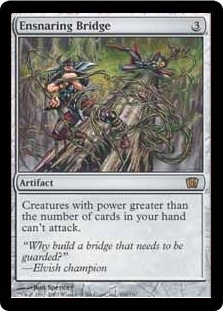 It worked perfectly with the low converted mana cost of the core combo cards, isn’t reliant on playing specific colors, and essentially plays like a Moat - but better. The effectiveness and function of Ensnaring Bridge is one of the primary events that lead to the inevitability described above.
It worked perfectly with the low converted mana cost of the core combo cards, isn’t reliant on playing specific colors, and essentially plays like a Moat - but better. The effectiveness and function of Ensnaring Bridge is one of the primary events that lead to the inevitability described above.
This discovery brought about additions like Pithing Needle and Surgical Extraction. Discard spells like the painless Duress and Inquisition of Kozilek provide information so that the pilot can make fully informed decisions on what the opponent is missing, picks out cards that may break the prison, and removes cards that may allow the opponent to win before a complete lock is set.
Abrupt Decay is a popular choice as a filler answer-all. It rarely is short of targets and frees up sideboard slots that would otherwise be filled with answers for cards like Stony Silence and Kataki, War's Wage.
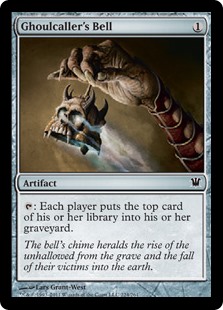 The manabase of the deck may look blasphemous in the current world of fetchlands and shocklands, but has been shown to be effective. Pilots should avoid lands that reshuffle the library and require them to pay too much life for relevant plays in the early game. The lack of self-shuffling effects effectively allows the pilot to “stack” his or her deck with each Ancient Stirring played, and life points are a precious resource to begin with (the deck also suffers from a rough Burn matchup, and fetches/shocks don't help). The most commonly played utility lands are Academy Ruins and Ghost Quarter. Ruins allows the pilot to reclaim countered, discarded, destroyed, or even self-milled artifacts as needed. Ghost Quarter acts as additional disruption against certain matchups, prolonging the game and increasing the likelihood of victory. The average converted mana cost is relatively low, so the deck runs efficiently on 18 lands and three Mox Opals.
The manabase of the deck may look blasphemous in the current world of fetchlands and shocklands, but has been shown to be effective. Pilots should avoid lands that reshuffle the library and require them to pay too much life for relevant plays in the early game. The lack of self-shuffling effects effectively allows the pilot to “stack” his or her deck with each Ancient Stirring played, and life points are a precious resource to begin with (the deck also suffers from a rough Burn matchup, and fetches/shocks don't help). The most commonly played utility lands are Academy Ruins and Ghost Quarter. Ruins allows the pilot to reclaim countered, discarded, destroyed, or even self-milled artifacts as needed. Ghost Quarter acts as additional disruption against certain matchups, prolonging the game and increasing the likelihood of victory. The average converted mana cost is relatively low, so the deck runs efficiently on 18 lands and three Mox Opals.
Card Choices: The Sideboard
Lantern Control's sideboard is designed partially to help shore up the deck's weaknesses and partially to pre-emptively answer expected cards that opponents will be sideboarding in. The most important aspect of the sideboard is for each card to be versatile as possible. Ancient Grudge assists in improving the Affinity matchup, but is also important to answer a Chalice of the Void. It has a role against Tron variants and Amulet Bloom decks as well.
 Grafdigger's Cage singlehandedly shuts down every copy of Collected Company and Chord of Calling in an opponent’s deck. It also does impressive work against decks like Grishoalbrand, and keeps the ever popular Snapcaster Mage from flashing back key spells that have been milled away.
Grafdigger's Cage singlehandedly shuts down every copy of Collected Company and Chord of Calling in an opponent’s deck. It also does impressive work against decks like Grishoalbrand, and keeps the ever popular Snapcaster Mage from flashing back key spells that have been milled away.
Nature's Claim and Seal of Primordium are designed to answer the troublesome Leyline of Sanctity, Stony Silence, and Suppression Field. They do double work against Robots, Tron, and Amulet Bloom as well.
Pyroclasm slows down many of the aggressive creature-based decks, like Merfolk, Delver variants, Elves, Affinity, and even slows down Burn: remember that a good amount of Burn's damage comes from creatures like Guide and Eidolon. Pyroclasms are included in order to keep the game going until an Ensnaring Bridge puts the opponent’s deck at a snail’s pace.
A fourth Sun Droplet is often interchangeable with a Sunbeam Spellbomb, depending on the build. Both cards address the otherwise abysmal Burn matchup, but they also have applications against similar decks as well.
Welding Jar assists in preparing against the often-included artifact destruction and opponent brings in. We run three in the sideboard, but you can even go up to four depending on the metagame. The Jund matchup typically has the most artifact destruction at its disposal, and Jund-heavy metagames might call for a full Jar playset.
Cards That Didn't Make the Cut
Lantern Control has been around since late 2012, despite only seeing serious play in the recent summer 2015 tournaments. In that time, Lantern Control players have tested dozens of alternate options and cards, many of which were ultimately cut in favor of better options. Here are just a few of the suboptimal cards that didn't make the final list.
Artificer's Intuition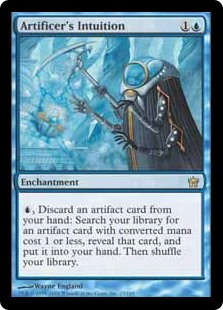
An enchantment that seems like it would fit great in the deck, and has been suggested a great number of times, Artificer’s Intuition is filling a role the deck doesn't need. It requires the same total mana investment as Trinket Mage, but without the 2/2 body and requires dumping an artifact in order to search one up. The game should typically already be locked up by the time this card is useful for what it’s suggested for, and it can’t get Ensnaring Bridge, which is often the last piece needed.
Trinket Mage
Speaking of the Mage, this card increases the average converted mana cost of the deck, putting it at odds with Ensnaring Bridge. It also only fetches out a select few cards in the deck. While there is the possibility to try the Mage out in a build more oriented towards a toolbox-type deck, this is not the direction that has proven most effective.
Life from the Loam
While it may seem like it plays well with the self-mill plan and is great for getting back an Academy Ruins, Loam is designed to put cards into your hand. That doesn’t bode well in a deck that is looking to empty the hand for Ensnaring Bridge in order to stay alive. Codex Shredder can do the same job, and is already a staple in the list.
Next Level Playing Tips
General Deck Tips
- Patience is its own reward
It isn’t uncommon for a newer pilot to become overly aggressive milling in the early game. The tried and true method is to wait until the end of the opponent’s turn and then evaluate if milling will do more harm than good. The early game is when a pilot should be more interested in keeping an opponent locked down. If an opponent has a card on top that will do him or her no good, then it is best to let him or her have it and to instead use the mill ability to assist you in digging deeper into your deck. And, of course, at the end of an opponent’s turn unless absolute necessity calls for it.
- Sometimes it is correct to “sandbag”

Correctly playing Ancient Stirrings is often the difference between a win and a loss. It’s better to allow an opponent to discard the Stirrings in hand than to use it and allow them to discard an Ensnaring Bridge. It is also correct to hold a Stirrings if the card that we intend to grab with it is already on top of our library. Why pay a green mana and spend a card to get something that the deck was going to give us anyway?
- Know your enemy
Surgical Extraction provides nearly all the information needed to make informed decisions, whether it’s the card that we need to name with Pithing Needle or the number of “outs’ an opponent has still left in the library. It also lets a pilot know if using that Ghost Quarter is going to shut out a color of mana or not, and may even be used as an instant speed discard spell during the draw phase.
- Playing slow is not playing patiently
It’s not uncommon for opponents to refuse to concede when they have been put into the prison. It’s also not uncommon for opponents to become emotionally upset when playing against Lantern Control, and decide to use alternate tactics like stalling and then attempt to blame a draw on the Lantern deck. This means that the Lantern Control pilot must not only be mentally aware enough to make the correct decisions, but to be able to do so in a timely manner in order to avoid going to time against an unhappy and vindictive opponent.
Single Card Tips
- Pithing Needle
Correctly playing Lantern Control typically requires a pilot to be intimately familiar with the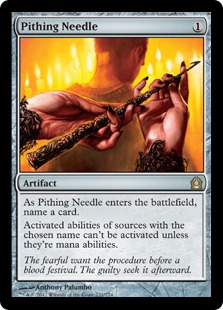 metagame. Nearly every deck has a card that Needle can shut off, and knowing which card(s) to name is the sign of someone who knows what they are doing.
metagame. Nearly every deck has a card that Needle can shut off, and knowing which card(s) to name is the sign of someone who knows what they are doing.
- Spellskite
Many misplays can be attributed to a misunderstanding of what can and can’t be targeted with Spellskite’s ability. It’s important to know the intricacies of this, or risk losing to what could be an otherwise silly mistake.
- Getting information: Inquisition of Kozilek, Duress, Lantern, and Surgical Extraction
These card provide the pilot with complete information. There is rarely an excuse for not writing down the cards seen when playing targeted discard. The more information available, the more likely a correct decision can be made when choosing when and when not to mill.
- Play order: Inquisition of Kozilek and Duress
In addition, it is logically correct to play Inquisition of Kozilek before Duress in the early turns of the game. Inquisition can be used to remove early threats, while Duress is often better for taking care of cards that have to wait for the prerequisite land drops to be played.
Sideboard Guide
Jund
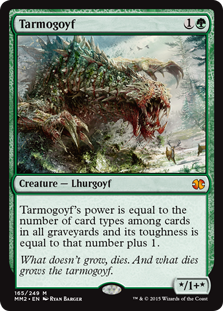 OUT
OUT
-1 Codex Shredder
-1 Ghoulcaller's Bell
-1 Duress
IN
+3 Welding Jar
Typically one of the deck’s worst matchup. The combination of a fast clock and large numbers of active cards make for a difficult matchup. The key card to name with Pithing Needle is Liliana of the Veil because an active Lily will take over the game.
Affinity
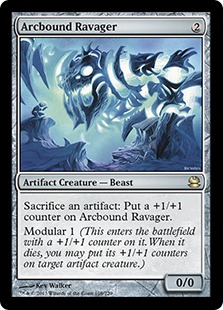 OUT
OUT
-2 Surgical Extraction
-3 Duress
-1 Ghoulcaller's Bell
IN
+1 Seal of Primordium
+1 Ancient Grudge
+1 Nature's Claim
+3 Pyroclasm
One of the more favorable matchups. The maindeck Pithing Needles and Ensnaring Bridges are supplemented with six cards out of the board, often leading to a very one-sided post-board game. The early game discard slows down the opponent’s deck until the rest of the cards stop it entirely.
Burn
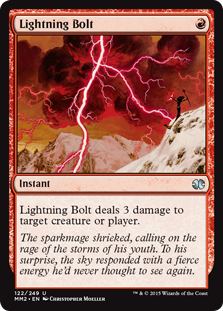 OUT
OUT
-1 Codex Shredder
-1 Ghoulcaller's Bell
-2 Surgical Extraction
-3 Pithing Needle
IN
+4 Sun Droplet
+3 Pyroclasm
+2 Welding Jar
One of Lantern Control's worst matchups (if not the worst matchup period). The additional Sun Droplets and Pyroclasms serve to prolong the game to the point where it doesn’t matter how much burn the opponent draws, it won’t be enough to overcome the Droplet lifegain. Welding Jars act as additional protection to give Sun Droplets, Spellskites, and Ensnaring Bridges the staying power needed to keep the prison intact against Burn's Wear // Tear, Destructive Revelry, and/or Smash to Smithereens. Jars also help drop the hand size quickly in order to bring the Bridge to full power as soon as possible.
RG Tron
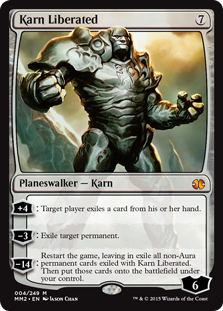 OUT
OUT
-1 Inquisition of Kozilek
-1 Codex Shredder
-1 Ghoulcaller's Bell
IN
+1 Seal of Primordium
+1 Nature's Claim
+1 Ancient Grudge
Maindeck Pithing Needles do major work in this matchup, while Ensnaring Bridges keep Wurmcoil Engines and even Emrakul, the Aeons Torn at bay. Bringing in the artifact hate helps out against Wurmcoils and Oblivion Stones if and when the Needles and Bridges aren’t set up yet. The sideboarding for this matchup is very tricky. Welding Jars can help against Oblivion Stones and the Nature's Claims/Ancient Grudges that an opponent may side in, but some RG Tron pilots will also side in Spellskites, making Jar a dead card.
Infect
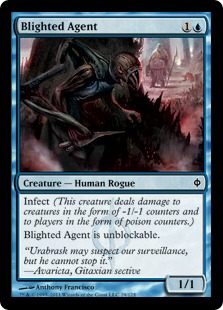 OUT
OUT
-2 Surgical Extraction
-3 Pithing Needle
-1 Ghoulcaller's Bell
IN
+3 Welding Jar
+3 Pyroclasm
The Infect matchup is typically a race against time. While Welding Jars do help to ensure that Spellskite and Ensnaring Bridge stay out, they are also extremely important in turning Bridge up to 11 as soon as possible.
Grixis Control / Grixis Twin
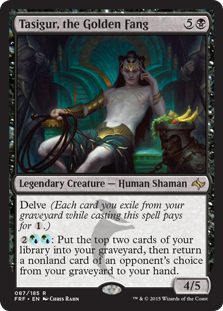 OUT
OUT
-1 Pyrite Spellbomb
-1 Codex Shredder
-1 Ghoulcaller's Bell
-1 Inquisition of Kozilek
IN
+2 Grafdigger's Cage
+2 Welding Jar
Against Grixis Control, we want to name Tasigur, the Golden Fang with our Pithing Needles, and then use the extra Needles for cards that we expect or know the opponent has against us. We can get that information from Surgical Extraction, but we can typically expect to see Engineered Explosives. If nothing else, we can name fetchlands. Against Twin variants, Needles are best to be set on Deceiver Exarch, Pestermite, and expected cards/fetchlands, in that order: remember that Splinter Twin gives the activated ability to the creature, so never, ever name "Splinter Twin" off Needle.
Company/Chord Variants (Abzan, Elves, Naya, Kiki, etc.)
 OUT
OUT
-2 Surgical Extraction (Elves)
-2 Abrupt Decay (Elves)
-1 Pithing Needle (Elves)
-1 Codex Shredder (-2 for non-Elves)
-1 Ghoulcaller's Bell (-2 for non-Elves)
-3 Inquisition of Kozilek (non-Elves)
IN
+2 Grafdigger's Cage
+3 Pyroclasm
+2 Welding Jar
While these decks have similar gameplans, what to take out can be very dependant on what particular build the opponent has. The main choice for Needle against Elves is Ezuri, Renegade Leader. Don't name Heritage Druid or other mana-ability Elves. CoCo Combo decks have a variety of choices, each dependent upon the build. Some versions go for Kiki-Jiki for the combo, others go for Viscera Seer and/or Cartel Aristocrat. Some builds run some number of Qasali Pridemage too, which is another viable Needle target.
Merfolk
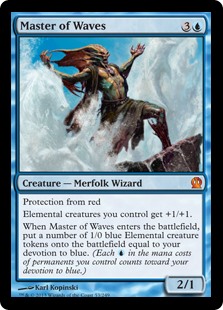 OUT
OUT
-3 Pithing Needle
IN
+3 Pyroclasm
Merfolk is typically one of the easier matchups. Pithing Needle is often the most dead card so it's easily traded off with Pyroclasms for some early game disruption when combined with discard spells. Once a Bridge hits the battlefield, it’s just a matter of keeping the opponent off of Hurkyl's Recalls, Echoing Truths, and so on. Some opponents will hold Lords in order to keep the fish small enough to swing under a Bridge if we have a single card in hand. Those opponents will often attempt to use Vapor Snag to bounce Spellskite to put a card in our hand to get this plan to work.
The Future of Lantern Control
Lantern Control will only get better as pilots become more comfortable playing it. It’s a daunting deck to handle and I've heard it said that it’s not much fun to play against. That said, it’s difficult to argue against the strength of being able to control what an opponent can draw as early as turn two. This often means that opponents just cannot risk keeping a hand that is anywhere near questionable. With Lantern Control's recent success at GP Oklahoma City fresh in everyone's mind, you can be sure we'll see more of the deck as Modern continues to evolve.
I hope that this has been informative, and I look forward to seeing more copies of this deck placing in events in the future! Do you have any experience with the deck? Any tips or tricks you want to share with the readers? What about lingering questions you have on the deck? Ask in the comments. Thank you for reading and I look forward to seeing more Top 8 Lantern Control finishes in the future.





Excellent article Mickey. Thanks for taking the time to do a write-up on this!
This! Thanks Mickey!
Awesome primer. I’ve been waiting to read about this deck for some time, and I wasn’t disappointed. I do have a bit of a curiosity, however, and it’s why a card like Elixir of Immortality doesn’t make your 75. Is Sun Droplet that much better? I’m also thinking that Elixir gives you life right away, and it also protects you from self-mill when you are primarily employing Ghoulcaller’s Bell to trim your opponent’s deck (it also gets artifacts from your graveyard into your library en masse). I’m sure you’ve considered it, so I’d like to hear any thoughts on it or why it wasn’t chosen.
The main reason is that Sun Droplet “sets” your life total and can also act as a mini-bridge for smaller creatures, especially stuff that sneaks under like Noble Hierarch. We have Academy Ruins to get back milled cards, which makes the shuffle effect on Elixir less useful. If you want a “gain life in a pinch” effect I would suggest Sunbeam Spellbomb (which is also used in some sideboards) as it can draw a card with no white mana, only costs 1 to activate, and most imporantly, can be recurred with Academy Ruins.
Also, excellent article, Randall! Sideboarding with this deck has always been a weak point for me (I’ve played the deck since January, but still) and this primer helps out a lot.
I would imagine it is because artifacts being in your yard are way better than then being in your deck thanks to academy ruins.
Incremental lifegain is better because of Skullcrack/Command; we want things in our graveyard, and it’s cheaper overall.
What I am most curious about the deck is that it can’t seem to win without an ensnaring bridge in play. So should you agressively mulligan for it? Is it enough to keep hand with academy ruins and self-mill hoping to “graveyard tutor” it?
Ancient Stirrings goes a long way in finding Bridge, or most anything in the deck really.
If you have Lantern and mill rocks you can dig for it while stalling the opponent by milling his creatures.
If you have mill rocks and Academy Ruins, yes, you could self mill in hopes of “graveyard tutor” it back. This is also how you find your Lantern some times.
Abrupt Decay & Pyrite Spellbomb also buy you time against creatures to find a Bridge.
So a hand without Bridge but with Ancient Stirrings is keepable?
Yes
Mesmeric Orb seems like a decent sideboard card for certain decks vs this.. oddly enough.
If the Lantern player has an Academy Ruins, Mesmeric Orb will not be able to do the trick. Mesmeric Orb will trigger, mill the Lantern player to 0 cards in library, then the Lantern player will use Academy Ruins to put 1 card on deck and draw it, turn after turn. Mox Opal’s legend rule means there will always be a target on graveyard to do it, or Codex Shredder saccing itself, or Pyrite Spellbomb.
I don’t think he meant as a win condition against the lantern deck rather a way to get out of the “lock”. Lantern player shapes your draw and then you mill a number of cards of hopefully revealing another out that the lantern player can’t deal with.
I don’t think it ‘s effective enough and it’s so narrow (what other deck do you want it for?) that sticking with the grudges, kitakis and suppression fields seems better.
What about the amulet bloom matchup?
Don’t worry about the amulet bloom matchup anymore…